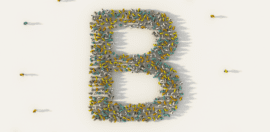Upparel co-founder says Australia must take responsibility for its textile waste

4 October 2022 at 3:16 pm
As she launches a new product to keep more textiles out of landfill, the co-founder of Upparel says Australia should be taking more responsibility for its waste.
Second hand clothing no longer “fit for purpose” can be made into new products in Australia, says Tina Elias, co-founder of B Corp, Upparel.
Upparel’s new product makes a ‘fill’ from unusable second hand clothing, effectively eliminating the need for textiles to end up in landfill.
Once clothing has been donated or repurposed, Upparrel creates filler that’s used in everything from cushions to mattresses, with insulation the next incarnation.
“Accountability for Australia’s textile waste should be a priority. We cannot make it someone else’s problem,” says Upparel’s co-founder Tina Elias.
Upparel was launched in 2020 and works by accepting clothing by an online system; the donator purchasing a label on their website, booking a slot, and simply leaving it on their doorstep for collection.
The B Corp, which is only two years old, has “diverted” 917,316 kilos of clothing waste from landfill – and it’s growing. Fast. Upparel has already expanded into New Zealand and works with some of the largest fashion retailers in Australia and New Zealand.
She explained the idea for the product was the consequence of the first business she and husband Michael started together.
“Back in 2016 [my husband] Michael was working for a ‘big 4 bank’ and I’d just had a baby. Michael suggested we start a subscription sock company. Within four years we were distributing to over 70 countries with 10s of thousands of subscribers.”
That company was Manrags.
“By 2019 Michael was clearing out his extensive sock drawer and we thought, ethically, we couldn’t throw them out, and we couldn’t donate them to charities because they are underwear. That was what got us thinking,” Elias explained of Upparel’s origin story.
At the time, when Michael and Tina Elias put a call out for consumers to return their old socks for up-cycling, they were inundated.
Tina Elias said the response was because of their commitment to sustainability, and to their online community.
“We had a sustainable ethos and listened to our community. They were and are very loyal because of that,” she said.
Large retailers, not for profits and corporates they work with include The North Face, Sussan, Tradie, Lee, Wrangler, Brooks Running, Australian Defence Apparel, Save The Children, Target, Rural Bank and Boeing.
“We sort out what can be donated, which is usually 60 per cent of the donations – and its really good quality clothing,” she said.
Items that are not fit for re-use are then turned into a commerical fill product.
“That includes recycled corporate uniforms that can’t really be re-used.
“The unusable clothing is turned into a product that can be used for housing insulation, furniture or pillows,” she says.
“Our fill is actually going to be used by a designer in next year’s Design Week in seats and couches. Denim is used by Australian high-end fashion designer Kit Willow.”
The product is called FillUP and is only available in a wholesale environment with a minimum sale of one tonne but, says Elias, the thing that inspires her and her husband Michael the most about what they have created, is that every part of the clothing that is donated is re-used.
Even zips and buttons are donated to sustainable fashion houses.
Funding, sustainability and a circular economy
It is an interesting time in the evolution of the circular economy in Australia, with fashion companies increasingly active in reducing their own contribution to the fashion waste issue and governments scrambling to catch up with public sentiment.
The Australian Financial Review reported that Australia is second only to the United States for its consumption of textiles, with 27 kilograms of new clothing and footwear each year.
SCRgroup business development executive Alexis Todorovski, who helped the Morrision government’s environment minister Susan Lay implement the National Clothing Product Stewardship Scheme told the publication “our textile recycling rate is very low” explaining that textiles due for landfill are often exported to “countries such as Malaysia and United Arab Emirates for sorting”.
The National Product Stewardship Investment Fund was set up by the Department of Climate Change, Energy, Environment and Water (DCCEEW) to combat waste and create better recycling pathways in Australia.
To-date it has funded 24 projects, invested $18.6 million with more than 1.6 million tonnes of waste projected to be diverted from landfill.
The National Clothing Product Stewardship Scheme, tasked with halving national textile waste by 2030, awarded The Australian Fashion Council $1 million in funding to compile data on the roots of the problem, with a report released in May this year.
The Australian Fashion Council has led a consortium including brands, manufacturers, retailers, reuse charities, fibre producers, academics and waste management companies to create Australia’s first National Product Stewardship Scheme for clothing textiles.
“The initiative aims to improve the design, recovery, reuse and recycling of textiles, providing a roadmap to 2030 for clothing circularity in Australia in line with National Waste Policy Action Plan targets,” a blurb on the research reads.
The report shows that Australians import almost 1.5 million units of new clothing into the country each year (2018-2019 figures) equating to 373,000 tonnes of fashion-specific textile.
Including locally made clothing the sum total is 383,000 tonnes of fashion-specific textile, or 56 items per person, weighing 14.8 kilos, according to the report.
It also shows annual clothing donations and other reuse is implemented by way of 2676 charities nationally equating to 210,000 tonnes saved from landfill.
But, says a passionate and vocal Elias, Upparel was not part of the report at all.
“Upparel wasn’t included in that report at all and we work with Apple, Sportgirl, Susan group, the Cotton On Group, bec and bridge – so many more,” she said.
“These are some of the largest textile producers in the country,” she added.
“We are excited because we have found a solution to landfill. We hope that FillUP can be used in hobby stores, in major buildings and even replace traditional insulation,” she said.
The Iconic is another company doing its best to stop fashion ending up as landfill.
It has partnered with the Salvation Army in a system similar to Upparel’s with an online printable label with recyclable clothing delivered free of charge by Australia Post to your nearest Salvos store. The program is called Giving Made Easy.
The Iconic Australia’s sustainability manager Emma Foster-Geering says the average Australian buys 56 new items of clothing each year and discards 38 items to landfill.
“Giving Made Easy offers an innovative and convenient way to help Aussies reduce their personal textile waste footprint by giving clothes a second lease on life,” she says.
Since 2020 the program has received over 8,640 donations, diverting an estimated 36,130 kilos of textiles from landfill.
“We noticed schemes already operating in overseas markets, based on the idea of making it convenient for consumers to send donations directly to charities without having to visit a store. We were [then] approached by Salvos Stores and Australia Post to co-develop the initiative,” she said.
“From there, we sketched out an approach and conducted two pilot projects, in October 2018 with 150 customers and in May 2019 with 600 customers.
“Insights from the two pilots informed the final design of the initiative, which is accessible to Australian customers and works on an opt-in basis, supported by marketing activity. We were able to launch Giving Made Easy in early 2020.”
The Iconic has also partnered with AirRobe, a second-hand fashion marketplace.
“Through a widget implemented on THE ICONIC, you can add your ICONIC purchases directly to [a] circular wardrobe, making them immediately available for you to resell, rent or recycle after you have loved and worn them,” she explained.
The Iconic also partners with Thread Together, an organisation that collects new clothing from fashion retailers and distributes it to people in need through a national network of charities and social service agencies.







